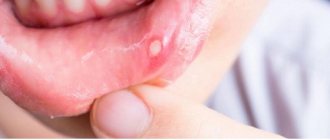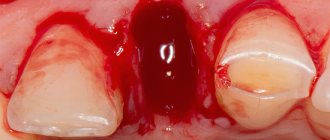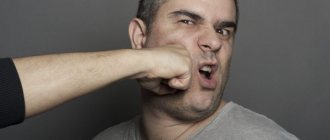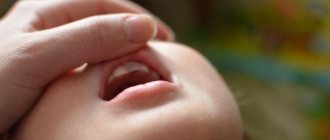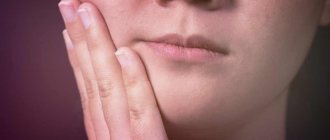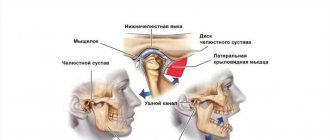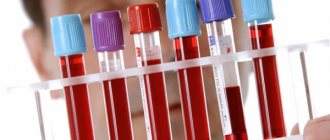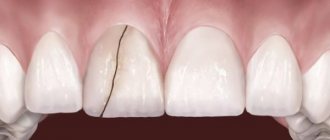Symptoms of bruise
A bruise manifests itself differently. Yes, you will also experience pain, but the bone integrity is not broken, there is no rupture of soft tissue, but there are abrasions or internal bruising. You have difficulty yawning, speaking, chewing, your teeth hurt, and your lymph nodes may be enlarged. But the jaws are connected to the skull; if desired, they can be closed and moved from side to side. Although such an injury is serious, it can still be treated well.
In the picture on the left you can see typical fracture lines that occur when hit by
lower
jaw
:
- Medium fracture;
- The second is the chin or is sometimes called mental;
- Fracture in front of the angle of the jaw or anterior angular;
- This is behind the angle of the jaw, also known as the posterior angular. This is the most common fracture;
- The fifth type is much less common and is called a fracture of the jaw branch; Well, the rarest is a fracture of the neck of the articular process. It happens very rarely, most often if the blow comes from the bottom to the top.
The right picture shows the lines of fractures of the upper jaw, everything is much simpler here:
- Upper jaw fracture;
- Average;
- And the bottom one.
Is it worth going to the hospital?
Here it is definitely worth saying that yes. The bruise goes away quickly, but you cannot assess the full extent of the damage. To do this you need to take an x-ray. The danger is that a bruise can have its consequences even without dislocation - periostitis, difficulty chewing in the future, the development of a tumor, an inflammatory process. The worst thing, of course, is that sarcoma can develop. Therefore, it is better not to delay diagnosis, go to a surgeon and dentist.
Bruise therapy
So, you received a strong blow to the jaw
. Unfortunately, this often happens, but the fact is obvious in every sense and cannot be changed. Now you need to devote time to treatment. It's very simple. Follow the steps described below after a visit to the doctor, when it is already known that there is no dislocation and the bones are intact.
Fracture after a blow to the jaw. Video
Effective treatment
Treatment is mainly done with cold. You can do:
- face coverings using wet, cold towels;
- You can use ointments against bruises. These are sold in pharmacies;
- Various folk methods can help heal abrasions - applying plantain, bodyaga, making an ointment from fat and chopped onions, washing with chamomile infusion;
- you can develop your jaw by opening and closing your mouth, turning your jaw to the sides;
- To speed up the healing process, the doctor prescribes UHF and dry heat therapy.
All this will help you return to a healthy life. Be sure to monitor the amount of calcium in the bones; the more it is, the stronger the bones. In the future, be careful.
A jaw bruise is a mechanical injury without compromising the integrity of the jaw skin and bone tissue on the face. In contrast to fractures and dislocations, in which the bone structure is disrupted and the skin is ruptured. The most common injury to the maxillofacial area is a bruise of the jaw, accompanied by injuries to the soft facial tissues. Such a bruise occurs due to the impact of a heavy, blunt, hard object on the soft tissues.
As a result, small blood vessels are damaged, abrasions, swelling, redness and hematomas are formed with severe pain on palpation. It becomes difficult for a person with a damaged jaw to chew, yawn, or speak. Lymph nodes become inflamed. The patient experiences general malaise and weakness. However, the jaw is still firmly connected to the skull.
Symptoms of a dislocated jaw
With complete or incomplete dislocation, the patient cannot close his mouth on his own, experiencing severe pain when trying. The jaw is protruded or twisted. Speech is impaired. There is severe pain in the lower jaw, radiating to the temple.
Bruised jaw: treatment and consequences of injury
Facial injuries are quite common. A jaw bruise is an injury without violating the integrity of the skin and bone tissue.
The main difference between it and a fracture is that the victim is able to close and open his mouth, although this causes serious pain. Only an experienced specialist can identify the problem and carry out differential diagnostics.
Most often, such injuries have a favorable prognosis, but it is necessary to undergo a comprehensive study to exclude possible complications. In addition, you should strictly follow medical recommendations and appear in a timely manner for preventive examinations if necessary.
Pain is the main symptom of injury
Causes of bruises in the maxillofacial area
Most injuries occur unexpectedly and to varying degrees of severity.
Most often they are observed in the following cases:
- falling onto a hard surface;
- due to collision with objects;
- various impacts (road traffic accidents, domestic fights, contact sports).
Falls are the most common causes of injuries to the maxillofacial area
The severity of such injuries largely depends on the affected area, the type of object that affected the bone tissue and age-related changes in facial tissue.
Damage to the lower jaw
This injury is the most common. It occurs in both children, adults and the elderly. The important point is to identify the type of damage as soon as possible and provide first aid. The further prognosis and duration of treatment will depend on this.
A mandibular contusion is a soft tissue injury in the lower parts of the face. As a result, an internal hematoma is formed due to the rupture of small blood vessels.
In the event of a bruise, the bone tissue remains intact and the teeth and gums are not injured. Usually occurs as a result of impact on the maxillofacial area with a blunt object. Bruise of the jaw after a blow to the lower parts of the face on the left side
The severity of the injury is largely influenced by the moment of impact. Severe consequences are observed with highly tense muscles. In this case, they rupture, forming an extensive hematoma with a pronounced pain reaction.
Main symptoms
Any disease has its own fundamental signs. Symptoms of a bruise of the lower jaw are usually quite striking. The main sign is sharp pain, abrasions, damage to the cheek or lip.
If the blow falls on the area of the dental arch, then gaping wounds form on the soft tissues on the side of the oral cavity. The lower lip looks swollen, sagging and hyperemic.
To make a correct diagnosis, differential diagnosis is necessary. It is important to exclude fractures of the bone areas of the jaw, eye socket and nose.
After a strong blow, the victim should not be left unattended. It is imperative to monitor his general condition. Together with complaints and external examination, a preliminary diagnosis can be established.
In addition to local signs, general manifestations should also be taken into account:
- damage in the form of scratches and hyperemia in the jaw area;
- swelling in the lower part of the face;
- the presence or absence of hematoma of varying volume;
- malaise and swollen lymph nodes;
- sharp or constant pain even at rest;
- impairment in mouth opening, eating and speaking;
- increased pain response from touching the damaged area, as well as movement of the jaw to the left or right side.
Attention!!! The main differential diagnostic sign of a bruise from a fracture is that the jaw bones do not change their anatomical structure. In addition, the line of bone integrity violation can be determined by palpation.
If the injury is severe, the victim must in any case be taken to a doctor for examination to clarify the condition. It is important to carry out rapid transportation with preliminary first aid.
Damage to the upper jaw
The nature of injury in this area is more complex. Its danger lies in the fact that serious complications may occur. It is quite easy to distinguish a bruise of the upper jaw from the lower one.
This is determined by the location of the pain and the consequences of trauma. However, it should be taken into account that unpleasant sensations can radiate to the lower part of the face. But the main difference here will be the absence of impaired mobility of the lower jaw.
The symptoms of a bruise of the upper bone tissues are very similar to the previous problem. There is an inflammatory process and pain, swelling, and sometimes enlargement of regional lymph nodes. Even if there are no obvious signs of bruises, you need to go to the clinic.
In the photo there are fractures of the upper jaw with severe bruises. The doctor must first rule out a fracture. In the upper jaw, such injuries are dangerous for brain damage.
For example, a Le Fort 3 fracture is a separation of the bones of the skull and face. Without professional medical care, death can occur in this case.
Diagnostic measures
If minor injuries to the maxillofacial area occur, they do not require contact with a dentist or surgeon, or urgent hospitalization. If there is severe and prolonged pain, the area of damage should be examined by a specialist.
The following are used as diagnostics:
- taking anamnesis;
- general examination by a surgeon, orthopedic dentist, traumatologist;
- special examination by an otolaryngologist, neurologist and other specialized specialists as necessary;
- X-ray examination of the maxillofacial area;
- CT scan;
- analysis of blood, urine, saliva.
Based on the data obtained, a general picture of the victim’s health is formed and a specific treatment is recommended.
The main therapeutic direction will be the following:
- taking painkillers;
- applying a pressure bandage;
- ensuring maximum peace for the victim;
- prescription of physiotherapeutic procedures;
- local and general anesthesia;
- elimination of hematoma and infiltrate.
First aid and treatment of bruises
Ice pack on problem area
Once the location of the damage has been identified, it is necessary to begin simple manipulations. Of course, they will depend on the nature of the damage. If there are open wounds, first of all they must be washed and treated with antiseptic.
Suitable products for this include hydrogen peroxide, Chlorhexidine, Miramistin, Bepanten. Before applying the antiseptic, the wound can be washed with soapy water. The bleeding area must be covered with a clean cloth or, if available, a sterile bandage.
Then apply cold to the affected area through the cloth. This can be an ice pack or a regular towel soaked in cold water, which is applied through a waterproof film.
For severe pain, the following medications are recommended by mouth:
- Analgin;
- Ketorol;
- Nurofen;
- Sedalgin;
- Nise;
- Took;
- Tempalgin;
- Nemesis.
Elements of treatment and means used
Immediately after injury, first aid must be provided. Usually, all bruises of the upper and lower jaw can be treated quite well without medical intervention. However, in case of severe lesions, it is still worth contacting specialists for examination.
Table No. 1. Painkillers:
Name of the drug Active substance Additional action Directions for use
Ketonal
Ketoprofen. Anti-inflammatory and decongestant. Apply a thin layer to the skin 2-3 times a day.
Fastum gel
Ketoprofen. Anti-inflammatory, improves blood circulation. Rub in the gel until completely dry 2 times a day.
Dolgit
Ibuprofen. Relieves swelling and inflammation. Apply with gentle massage movements, 3 times a day, up to 3 weeks.
Finalgon
Nonivamide, Nicoboxil. Improves blood circulation, recommended on the 3rd day after injury. After application, it is recommended to cover the affected area with a warm cloth.
Indomethacin
Indomethacin. Anti-inflammatory. Children apply no more than 1 cm of gel, adults no more than 15 cm, 2 times a day.
First of all, cold is applied to the lesion. Low temperatures will help not only relieve swelling and stop bruising, but also provide partial pain relief.
For the most effective elimination of unpleasant sensations, it is necessary to take analgesics internally or apply special ointments externally. Modern drugs are available in the form of gels. They are easy to use, absorb quickly and do not stain clothes.
It is good to use products that contain Heparin. It helps to quickly get rid of infiltration and eliminate the phenomenon of swelling. Heparin-based drugs should not be used by persons with bleeding disorders.
If the gel contains horse chestnut extract, it is contraindicated for people suffering from kidney disease and pregnant women. To prevent side effects from using the gel or ointment, the attached instructions should be studied in any case.
Table No. 2. Coolants:
Name of the drug Active substance Additional action Directions for use
Ben-Gay
Menthol, methyl salicylate. Painkillers, anti-inflammatory Apply in large quantities 3-4 times a day.
Flexall
Aloe vera extract, menthol, camphor, vitamin E. Quickly relieves pain and has an anti-inflammatory effect. Apply in a thin layer without rubbing.
Bystrum gel
Ketoprofen, Trometamol, essential oils. Decongestant and painkillers. Rub in with smooth movements until completely dry.
Reparil gel
Escin, salicylic acid. Decongestant, anticonvulsant, painkillers. Apply with light massage movements, 3-4 times a day, no more than 14 days.
The price of medications in the form of gels and ointments ranges from 220 rubles to 350 rubles. One package is completely enough for a course of treatment.
It is difficult to predict when a particular injury will occur. To reduce the risk of bruises and other injuries, precautions should be taken. In winter, move carefully on slippery sidewalks; in summer, when engaging in active sports, think through the possible consequences.
Folk remedies
There are several proven, simple and at the same time effective ways to have the positive effects of alternative medicine. They are indispensable products for pregnant women, children, as well as people who have a severe allergic reaction to medications. You can make a choice based on personal preferences or doctor’s recommendations.
Treatment at home for bruises can be carried out using the following means:
- Table salt solution. Compresses are prepared from it, which are used for any complexity of bruises. To prepare, a tablespoon of salt is dissolved in 150 ml of boiled water. Then take a sterile bandage, soak it in the solution and apply it to the problem area. The compress is covered with a thick cloth on top. The gauze pad with salt can be left overnight.
- Grated potatoes. The tubers should be washed and cleaned first. Grate one tuber on a coarse grater, place in linen cloth and wrap several times. After applying the bruise, cover the top with a thick towel. Compressor exposure time is 30-40 minutes. For best results, make 3-4 applications in a row.
- Cabbage leaf. Before applying it, you should knead it a little or make cuts on it to let the juice out. The sheet is applied to the sore spot 2-4 times a day until it dries completely.
- Onion and garlic. The two ingredients are ground and mixed together. The resulting slurry is added with half a tablespoon of salt; it is recommended to wrap the mixture in gauze and place it in the area of the bruise.
- Beetroot and liquid honey. Finely grated root vegetables are mixed with a tablespoon of natural honey. The procedure is carried out 1-2 times a day for 2 hours.
- Laundry soap. This remedy helps reduce the pain response. The soap is grated and mixed with raw chicken yolk. I apply a compress every half hour up to 6-8 times a day. You can also rub a damp cloth with laundry soap and apply an application to the bruised area.
- Apple vinegar. This is one of the most effective remedies. To prepare the solution, you need to take 2 teaspoons of vinegar and dilute it in 1 liter. water. Soak a clean cloth in the solution and apply 3-4 times a day for half an hour.
Popular folk remedies for bruises
This article shows how to properly apply a warm and cold compress for bruises.
Possible consequences
A bruise is not usually considered a serious injury. However, if you neglect the necessary treatment, unpleasant consequences arise. For example, the result of a bruise of the lower jaw can be a violation of the depreciation of muscle fibers, changes in the cartilage tissue of the joint and a speech defect.
On the muscle side, post-traumatic myositis develops as a complication. It is an inflammatory process, which is subsequently difficult to respond to therapeutic effects.
Attention!!! Bruises of various etiologies often become the cause of the formation of oncological tumors. Timely diagnosis and proper treatment can completely eliminate this complication.
With insufficient attention to the problem, jaw deformation, post-traumatic periostitis and even osteomyelitis occur. Abscesses and phlegmons may form in soft tissues.
Such conditions require long-term therapy, with a long recovery period.
Injury to the maxillofacial area is not a trivial matter. It is worth treating this problem with increased attention. Of course, many of them go away on their own. However, ideally any injury should be examined by a medical professional.
Read more…
Source: https://zen.yandex.ru/media/id/5a6202f78c8be30211b63841/5a7d8acc168a9194ae11e76a
Possible consequences of a blow to the jaw
So, the clinical symptoms of any jaw injury are more or less similar. Therefore, in the event of an injury, it is necessary to immediately take an x-ray, which will differentiate the type of injury and prescribe adequate treatment.
If diagnosis and treatment are not followed, serious complications may occur.
Consequences of a bruise
The result of an neglected bruise can be post-traumatic with subsequent deformation of the jaw, which in turn will require long-term complex treatment.
As a result of a bruise in the area of the masticatory muscles, inflammation of the bone tissue can occur - post-traumatic myositis, as well as limitation of joint mobility. Serious consequences can occur after a child’s jaw is bruised during the formation of its periosteum.
As a result, sarcoma develops. In case of such a bruise, surgery is necessary.
Consequences of a fracture
The consequences of a fracture are just as serious. This is the probability of pathological displacement of one row of teeth relative to another - either from bottom to top, or from front to back. Along the fracture line, gaps may form between the teeth. Jaw fragments are displaced. A malocclusion occurs. There is a loss of sensation in the lower part of the face. With a double fracture, the tongue sinks. In some cases it happens.
As a result of a jaw fracture, serious diseases can subsequently arise - osteomyelitis, meningitis.
Getting a jaw bruise as a result of any physical impact is a fairly serious injury. Any form of impact on this area requires timely diagnosis and surgical treatment.
Recovery from damage is quite problematic and painful. It can take quite a long time, depending on the overall severity of the injuries received, the characteristics of the body, age, gender and the characteristics of proper treatment. In order for the treatment to take place in a mild form and without consequences, you need to have some understanding of such an injury.
Damage to the lower jaw
This injury is the most common. It occurs in both children, adults and the elderly. The important point is to identify the type of damage as soon as possible and provide first aid. The further prognosis and duration of treatment will depend on this.
A mandibular contusion is a soft tissue injury in the lower parts of the face. As a result, an internal hematoma is formed due to the rupture of small blood vessels.
In the event of a bruise, the bone tissue remains intact and the teeth and gums are not injured. Usually occurs as a result of impact on the maxillofacial area with a blunt object.
Bruise of the jaw after a blow to the lower parts of the face on the left side
The severity of the injury is largely influenced by the moment of impact. Severe consequences are observed with highly tense muscles. In this case, they rupture, forming an extensive hematoma with a pronounced pain reaction.
Main symptoms
Any disease has its own fundamental signs. Symptoms of a bruise of the lower jaw are usually quite striking. The main sign is sharp pain, abrasions, damage to the cheek or lip.
If the blow falls on the area of the dental arch, then gaping wounds form on the soft tissues on the side of the oral cavity. The lower lip looks swollen, sagging and hyperemic.
What is a jaw bruise?
A bruise in this area includes mechanical damage of varying degrees, without any changes in the integrity of the skin and bones. Open injuries are also combined with a bruise. Belongs to the category of facial injuries.
The main reason for such consequences is receiving a strong blow from a fall, or from a fairly strong and sharp collision with hard objects. This injury is not considered complex, but is accompanied by severe compression of the soft tissue at the site of injury. Recovery from such exposure occurs mostly without serious consequences, but only in the case of prompt diagnosis and proper treatment.
Consequences of facial trauma
A blow to the front of the head is often accompanied not only by pain, swelling and bruising, but also by numbness at the site of injury. This symptom should not be ignored, since numbness of the face due to bruises may hide damage to the brain and facial bones.
Refusal to visit a doctor and lack of necessary therapy usually cause serious consequences:
- infectious inflammation of the hematoma;
- deformation of the nasal septum;
- suppuration in the area of the bruise in the form of an abscess;
- respiratory dysfunction.
Chronic sinusitis or sinusitis also often develops after such an injury. A bruise and numbness in the face is a reason to consult a doctor. A visit to a traumatologist is important, since only a specialist will be able to determine whether the victim has suffered a traumatic brain injury.
Accurate diagnosis of injury
Regardless of the external visual symptoms that arise from jaw injuries, they must be correctly diagnosed
. With any damage, there are certain characteristic signs. This forms the necessary treatment and helps to find out if there are any more serious damages, for example, a break, a crack, etc. To do this, you immediately need to take an x-ray, and based on the resulting image, the doctor will form a conclusion on the problem.
Using the information received, the doctor will be able to accurately indicate the cause of discomfort or other side effects. If a visit to a doctor is delayed, various inflammatory processes in the surrounding muscles, teeth and gums are possible.
What is the characteristic of a bruise?
When complaining of rather unpleasant pain in the jaw area, it is quite difficult to immediately determine the category of injury and its scale. In the absence of a fracture, but in the presence of an injury to the upper or lower part, the pain is not as pronounced. Despite the painful effect, movement may not be difficult.
In case of fractures, such actions are almost impossible to carry out. In addition to the painful effects on the bone, impacts also injure small blood vessels. Depending on the intensity of exposure, various abrasions may appear on the skin. The main manifestations of a bruise are:
- The appearance of acute pain at the site of injury when pressed or any physical impact.
- Various degrees of swelling and redness of the skin and the presence of hematomas are possible.
- When moving, painful symptoms appear. Pain can appear both at the site of the blow and throughout the face, a manifestation of toothache.
- The presence of general malaise, a slight increase in body temperature, low tone and weakness throughout the body.
Similar symptoms may appear in other cases of injury, so if you suspect critical consequences of a fall or impact, you should immediately seek medical help.
Complications and consequences
When a bruise affects the deep layers of facial tissue, complications may arise. Possible complications of facial bruises include the following:
- facial nerve damage;
- concussion;
- chewing disorder;
- nasal deformation, rhinitis, sinusitis, sinusitis;
- blurred vision;
- compaction in the area of the bruise, some infectious inflammatory complications in the form of suppuration: abscess, phlegmon, etc.;
- formation of cysts based on deep volumetric hematomas;
- shock, asphyxia, severe blood loss;
- bone fractures.
The upsetting consequences of such injuries can be scars remaining for life after stitching open wounds, loss of vision if the eye or nerve is severely damaged, etc. To avoid all possible troubles with your face, you must always be careful and follow safety precautions in everything, and if something happens, do not self-medicate, but urgently seek qualified help.
Dear readers of the 1MedHelp website, if you still have questions on this topic, we will be happy to answer them. Leave your reviews, comments, share stories of how you experienced a similar trauma and successfully dealt with the consequences! Your life experience may be useful to other readers.
First aid and treatment
In the absence of serious bone damage, there is no special therapy in this case. In fact, you need to visit the doctor once to diagnose the consequences of the blow, and after his recommendations you can go for home treatment. General recommendations for treatment:
- For any strong physical impact without critical consequences, it is recommended to apply cold compresses to the sore spot. Their regular use will reduce pain and prevent bleeding of soft tissues, and help relieve swelling.
- If in the first days there is constant aching pain, then you can use an anesthetic.
- The main condition for rapid relief and recovery is the creation of conditions of complete peace. To do this, you need to use a tight bandage that will help ensure proper fixation. In no case is it recommended to warm up the sore spot, as this will only increase the inflammatory effect.
First aid
Before proceeding with the treatment of the emerging pathology, the victim should be given first aid and taken for examination to a traumatologist in order to refute more serious damage to the bones of the skull (fracture, dislocation, displacement).
First of all, it is necessary, using available auxiliary items, to ensure cooling of the injured area. If the injury occurred at home, it is recommended to apply ice, frozen meat, vegetables or fruits to the bruised area of skin.
It is worth remembering that direct contact of the cold compress with the skin is not allowed. It is better to wrap ice products with a towel, rag or bag.
If the injury occurred on the street or in another place where it is not possible to get ice from the refrigerator, doctors recommend using snow, rags (pieces of things) soaked in cold water, bottles of cold water or iron tools. In such situations, it is also very important to avoid direct contact of the object with the skin, because you can introduce an unfavorable infection into the resulting wound area.
To eliminate excessively intense pain, you can take a non-steroidal painkiller.
Under no circumstances should heating the damaged area be allowed. Such manipulations do not improve, but only worsen the situation.
The jaws, the field of a cold compress, should be kept at rest (wrap with a bandage or other material at hand) and go for examination to the hospital, where the doctor will tell you in more detail about the treatment of the bruise.
Possible complications
There are situations when various negative consequences can arise as a result of a bruise. They occur infrequently if the patient strictly follows the doctor’s instructions and maintains speech rest. If the inflammatory processes in the bone are not removed in time, then deformation may occur in the future. In this case, treatment can be significantly extended.
If the affected area was in the area of the masticatory muscles, then as a result of post-traumatic inflammation, the natural mobility of the jaw joints may be disrupted. To avoid the occurrence of varying degrees of inflammatory processes in the gums, it is recommended to visit a dentist. This will help you be sure that any negative aspects of tooth loss will be excluded.
A jaw bruise is an injury caused by mechanical force.
A distinctive feature of this injury is the absence of violation of the integrity of the skin on the face and the bone jaw structures. As a result of injury, soft tissue is compressed and small blood vessels are damaged, causing a bruise to appear at the site of injury.
A hematoma can additionally form in the nasal and infraorbital area. Contusion of the lower jaw is considered the most common injury compared to dislocations and fractures of the jaw. Let us consider the characteristics of this pathological condition, symptoms and nuances of therapy.
Damage to the upper jaw
The nature of injury in this area is more complex. Its danger lies in the fact that serious complications may occur. It is quite easy to distinguish a bruise of the upper jaw from the lower one.
This is determined by the location of the pain and the consequences of trauma. However, it should be taken into account that unpleasant sensations can radiate to the lower part of the face. But the main difference here will be the absence of impaired mobility of the lower jaw.
The symptoms of a bruise of the upper bone tissues are very similar to the previous problem. There is an inflammatory process and pain, swelling, and sometimes enlargement of regional lymph nodes. Even if there are no obvious signs of bruises, you need to go to the clinic.
The photo shows fractures of the upper jaw with severe bruises
The cause of the injury is a blow
The main cause of injury to the lower or upper jaw is a blow with a blunt object, which can be received in various life situations:
- fight;
- consequences of a transport accident;
- unexpected fall onto a hard surface (for example from a bicycle, scooter or while playing on the playground);
- sports injuries - usually caused by failure to follow safety rules;
- production damage, etc.
In addition to the above circumstances, a bruise in the jaw area can appear after dental procedures (for example, removal of a wisdom tooth). In this case, the injury occurs due to incorrect operation or the complexity of the molar extraction process itself, which requires auxiliary manipulations to extract the tooth root from the gum.
Features of treatment
Immediately after injury, the victim should be given first aid. A compressive bandage made of a bandage or other available material is applied to the injured area.
If there is bleeding, the wounds are thoroughly disinfected; hydrogen peroxide or Chlorhexidine solution can be used. Ice or just a cold object should be applied to the bruised area as quickly as possible.
In a medical facility
When visiting a traumatologist, the specialist first conducts a visual examination. To exclude more dangerous injuries, the patient must undergo x-rays and CT scans, after which the correct treatment will be prescribed.
Therapy for jaw bruises includes certain rules, these include:
- applying a tight bandage to quickly restore damaged tissue and secure the bone in the correct position;
- in the first 2–3 days – cold therapy, which involves applying cold compresses with ice to the damaged area;
- treatment with a course of physiotherapeutic procedures - UHF, Sollux, ozokerite applications, dry heat, etc.;
- pain relief with tablets (Nurofen, Diclofenac, etc.).
If there is an extensive hematoma or tumor on the face, traumatologists prescribe special ointments, for example Finalgel, Troxevasin, Badyaga. They promote rapid healing of soft tissues, resorption of bruises, and also have an analgesic, antitumor and cooling effect.
At home
Treatment of jaw injuries at home requires the patient to follow certain recommendations that guarantee further recovery. It is important to follow all the rules to prevent the development of various inflammatory processes and other complications. Nuances of home therapy:
- applying cold applications for three days from the moment of injury at intervals of 30–40 minutes (10–15 times a day);
- adherence to the diet - during the rehabilitation period, you should avoid hard, spicy, too hot foods; it is preferable to eat pureed foods, as it is painful for the patient to chew;
- ensuring complete physical rest;
- To relieve pain, swelling and bruising, you can use pharmaceutical gels or use folk recipes (ointments based on animal fat, alcohol tinctures of horsetail, birch buds, bearberry).
Elements of treatment and means used
Immediately after injury, first aid must be provided. Usually, all bruises of the upper and lower jaw can be treated quite well without medical intervention. However, in case of severe lesions, it is still worth contacting specialists for examination.
Table No. 1. Painkillers:
Name of the drug Active substance Additional action Directions for use
Ketonal
Ketoprofen. Anti-inflammatory and decongestant. Apply a thin layer to the skin 2-3 times a day.
Fastum gel
Ketoprofen. Anti-inflammatory, improves blood circulation. Rub in the gel until completely dry 2 times a day.
Dolgit
Ibuprofen. Relieves swelling and inflammation. Apply with gentle massage movements, 3 times a day, up to 3 weeks.
Finalgon
Nonivamide, Nicoboxil. Improves blood circulation, recommended on the 3rd day after injury. After application, it is recommended to cover the affected area with a warm cloth.
Indomethacin
Indomethacin. Anti-inflammatory. Children apply no more than 1 cm of gel, adults no more than 15 cm, 2 times a day.
First of all, cold is applied to the lesion. Low temperatures will help not only relieve swelling and stop bruising, but also provide partial pain relief.
For the most effective elimination of unpleasant sensations, it is necessary to take analgesics internally or apply special ointments externally. Modern drugs are available in the form of gels. They are easy to use, absorb quickly and do not stain clothes.
It is good to use products that contain Heparin. It helps to quickly get rid of infiltration and eliminate the phenomenon of swelling. Heparin-based drugs should not be used by persons with bleeding disorders.
If the gel contains horse chestnut extract, it is contraindicated for people suffering from kidney disease and pregnant women. To prevent side effects from using the gel or ointment, the attached instructions should be studied in any case.
Consequences of a bruised jaw injury
Complications from a jaw bruise develop extremely rarely, but regardless of this, it is worth paying close attention to the therapeutic and rehabilitation period.
Successful recovery without post-traumatic complications is possible only if you follow all the doctor’s recommendations (rest, gentle nutrition, wearing a fixation bandage, etc.).
Incorrect treatment or neglect of the pathological condition can lead to related problems. These include:
- myositis of the masticatory muscles (often occurs with trauma to the lower jaw) is an inflammation localized in the muscle structures and difficult to treat;
- periostitis is an inflammatory process in the periosteum, characterized by the release of purulent accumulations; this anomaly often causes the formation of jaw deformities and malocclusion (we recommend reading: eliminating inflammation of the periosteum that occurs after tooth extraction);
- contracture is a painful condition in which there is a motor restriction of bone, mucous and muscle tissues: after a blow to the jaw, the patient will not be able to fully open or close the oral cavity, the extreme position will be strictly fixed.
In young children, the consequences of a jaw bruise can be more tragic and lead to oncological complications. Due to the incompletely formed periosteum, sarcoma (malignant neoplasm) develops in childhood; the disease requires immediate therapy and surgical intervention.
Hello, dear site visitors. I am often asked, why does knockout occur? Why is the jaw a favorite target for boxers? And how to perfect a clear hit on it?
Degrees and associated symptoms
Depending on the type of injury, signs vary. The main symptoms are as follows:
- Bruise: tolerable pain in the area of impact;
- slight hematoma and swelling;
- discomfort while eating or talking.
Dislocation:
- severe pain when trying to open or close your mouth;
visual deformation of the joint;
| Fracture grade | View | Symptoms |
| Lightweight | Crack | Sharp pain when trying to move your jaw |
| Swelling | ||
| Difficulty speaking | ||
| Average | Closed with offset | Aching pain even at rest |
| Swelling, hematoma due to tissue injury from bone fragments from the inside | ||
| Salivation | ||
| Headache | ||
| Weakness | ||
| Heavy | Open with offset | Unbearable pain |
| Bleeding | ||
| Unnatural facial distortion due to nerve and muscle damage | ||
| Loss of consciousness | ||
| Inability to eat, drink, speak | ||
| Bone fragments protrude from the wound |
Right punch to the jaw
Correct blows to the jaw allow you to quickly achieve victories. But they need to be trained. Do you know why a blow to the jaw leads to loss of consciousness? It is important to understand which boxing techniques can lead to such a result. We also need to learn not to fall under such attacks ourselves. It's good if your neck muscles are well developed. So in the event of a defeat, they absorb potential concussion.
And to achieve the goal, you can work with direct and side blows. But how to proceed to hit the jaw correctly?
Direct attacks are inferior in power to side attacks. After all, during a direct attack, the neck muscles absorb the impact energy, and the head does not lean back very quickly.
Lateral executions are more difficult to defend against. And if you want to instantly turn off your opponent, use them.
The most vulnerable area is the entire lower jaw. There is an abstract vertical line down from the corner of the mouth. You need to get to its center.
Use the heel of your palm. Turn your fingers outward. Attack directly. Move your elbow slightly to the side. The impulse follows from it to the middle of the palm. Hit the areas between the back of the head and the enemy's ear. Work big.
A good result for you will be achieved if you skillfully attack with a counter attack (counter assault). The key to victory here is sharpness and toughness. In the final phase of the attack, the fist is clenched powerfully. You use your feet well. The fist is triggered first, followed by the shoulder girdle, back, leg and ankle.
How to properly strike the lower jaw if it has a different curve? A powerful side slap works great here. The middle of the palm is also involved. You can attack from the side from the elbow. At a modest distance, the anvil technique is used: with your free hand, hold your opponent's head across the ring.
A correct blow to the jaw and subsequent knockout are associated with a competent defeat of this target from below. The uppercut works great here. Example:
You can work with the edge of your palm from the place of your thumb.
If for some reason you want to seriously injure your opponent, and are puzzled by how to properly break his jaw with one blow, then you can use the following technique:
- Use your palm in a straight line.
- Twist it from your side and down.
- After an assault, the opponent's jaw may break, become dislodged, or fall out of its groove.
Of course, many people want to achieve victories in boxing matches. Someone wants to knock out an opponent without fail, while inflicting significant injuries on him. For some, a victory on points or a knockout without particularly serious injuries is enough. And if you are tormented by the question of how to hit to break a jaw, think about whether it is necessary to reduce the situation to fractures? Of course, anything can happen in battle, and fractures may not be caused intentionally. But it’s better to do without them, because this is boxing, not a fight with street bandits.
Jaw bruise treatment at home | Portal about traditional medicine
Jaw bruise: background, symptoms, treatment.
No person is immune from jaw injury; the most famous anomaly is considered to be a jaw bruise (ICD-10 S00-S09). With all this, you can get injured at any age.
Jaw bruises occur due to various incidents: starting with disasters of varying levels of severity and ending with injuries from a blow received as a result of a street fight.
A blow to the jaw affects the soft tissues of the face, blood arteries and capillaries. This leads to the formation of hematomas and edema. People feel severe pain and discomfort.
The main reasons leading to bruises and other injuries to the jaw include:
- a fall, a bruise to the jaw after a blow, or other contact with any hard surface, which happens quickly and in one moment;
- a skirmish - it can be just childish fun or a harsh adult showdown;
- tragedy, for example, a fall from a bike, scooter, bike, as well as various road accidents in which the blow fell on the front of the head.
A jaw bruise is an injury that occurs without disturbing the structure of the bones and the integrity of the facial skin. It is quite common and differs from a fracture in that when it is bruised, you can clench your teeth.
- Painful sensations occur at the site of injury, which increase with physical contact with the area of injury. For example, palpating the site of a bruise.
- Swelling and redness are created. Abrasions or hematomas may appear at the site of the injury.
- It's hard to eat. It is difficult to yawn, talk, etc. But a person will be able to bare his teeth, even though it will cause pain.
- Toothache also occurs. It becomes brighter if you press on the teeth.
- The lips may begin to bleed and become swollen.
- It will be difficult to move your jaw.
- If a person wears braces or dentures, it may feel uncomfortable to wear.
- There is inflammation of the lymph nodes.
The person begins to feel a deterioration in his condition. Only an X-ray or computed tomogram can completely determine whether a person has a bruised jaw. This will also help identify which jaw is affected:
Trauma to the upper jaw can be dangerous. The upper jaw is connected to the nose, eye sockets, maxillary sinus, and is also inseparable from the bones of the skull. The least dangerous is a contusion of the lower jaw (ICD-10 defines the code for this anomaly as S00-S09).
1st aid
How to provide proper first aid for a bruise? It has pleasant symptoms:
- change in skin color;
- severe pain occurs;
- the tissues begin to swell.
Cooling down will be a simple first aid for a bruised jaw, the ICD-10 code is S00-S09 - we have already dubbed this anomaly. As a cooling item, you can take anything - from a plastic bag with snow to a heating pad with ice water. A pressure bandage is definitely needed on top.
After which it is important to keep the crooked jaw at rest and deliver the patient to the trauma department as soon as possible. When the victim complains of severe pain, it is allowed to give him an anesthetic. Heating bandages for such injuries are strictly prohibited, because this will provoke the development of inflammation.
At the clinic, you need to take X-ray pictures to accurately determine whether it is a fracture or a bruise. It's impossible to find it any other way. You also need to know that this injury is often accompanied by a concussion.
You need to undergo a medical examination to rule out severe jaw injuries, be it fractures or damage to the bones of the skull.
Successful healing of a jaw bruise at home can only happen when a clear diagnosis is known and possible complications are prevented.
Healing with medicines
For jaw bruises, the victim is prescribed medical treatment, which consists of taking painkillers to relieve pain, as well as various externally administered anti-inflammatory medications that relieve swelling and cyanosis.
Cold may initially help with similar injuries. It not only relieves swelling, but also helps stop bleeding. Many ointments and gels have this effect.
They are easy to use, quickly absorbed into the skin without staining clothes.
Relieve pain
Drugs recommended for excessive pain:
External application
External agents prescribed for bruises:
Pharmaceutical preparations containing heparin are very effective. It copes well with subcutaneous accumulations of blood and lymph, and also perfectly relieves swelling. But this product has some contraindications.
People with poor blood clotting are prohibited from using such medications. Some gels contain horse chestnut extract, which is strictly contraindicated for pregnant women and people with kidney disease. Therefore, before using any medication, you need to study the instructions for use.
Healing with traditional means
This type of elimination of the consequences of a jaw bruise is used in tandem with conventional medical treatment. The most famous types of healing using traditional means:
- It is necessary to apply plantain leaves, crushed wormwood leaves, and finely chopped onion to the jaw. All these pastes are applied as a compress to a bruise. As this mass dries, it must be removed and a new one put on.
- The most popular and effective method remains bodyaga; it is purchased at a pharmacy, mixed with water to medium thickness and applied to the bruised jaw.
- If there are bruises and bruises at the site of the injury, it is necessary to use herbal tinctures infused with vodka in the form of compresses. Tinctures are suitable from the following plants: bearberry, knotweed, horsetail, bean shell, also birch leaves, blue cornflower. If they are not available in the form of alcohol tinctures in the pharmacy, you need to purchase them in dry form, pour them into a container, grind them, add vodka and leave them in a dark place for a certain number of days.
- To eliminate the consequences of a bruise, an ointment that can be made without the help of others is perfect. To do this, you need at least some fat (pork, chicken), add sea salt and chopped onions. The first task of the remedies used to treat a bruise is to relieve pain. The first day after receiving a bruise, you can only apply cold. And the next day you can already apply various ointments, lotions and tinctures of pharmaceutical herbs in the form of compresses.
The best tinctures and ointments
Folk tinctures and ointments that were used by our forefathers:
- To get rid of pain, you need to prepare a follow-up ointment. Mix nutria fat and hop cones. Apply to the affected part of the jaw. Within 2 days the pain goes away.
- Take vodka and camphor. The lotions must be soaked in the prepared product. After the bandage or cloth that you use in the form of gauze dries, it must be immediately wetted again.
- Lotions made from tinctures or decoctions of mountain arnica. If there is no such infusion at the pharmacy, we buy the dried concentrate, boil the water, and throw in the weed. We leave it, wait until it cools down, strain it and apply it to the unhealthy area.
- Cabbage leaves relieve swelling and heat from the affected area. Just take a clean sheet and apply it to the impact site.
All these pharmaceutical methods from Mother Nature can be used only after a qualified examination by a doctor. If, after examination, he says that the bruise can be treated at home, only then can the means described above be used. Also, as prescribed by the doctor, you can alternate pharmaceuticals with lotions and herbal compresses.
Consequences
Like any damage, the described condition, if treated untimely and incorrectly, can serve as a prerequisite for very sad consequences and a rather sharp deterioration in well-being.
Source: https://zdorovyavsem.ru/bolezni/ushiby/ushib-chelyusti-lechenie-v-domashnih-usloviyah
State of the brain after jaw damage
Since the anatomical location of the jaw is such that certain actions can cause a concussion, it becomes a frequent target during combat.
Missing an attack on it does not immediately cause pain. The fighter temporarily loses consciousness. So why does a blow to the jaw knock a person out so much?
Here we can recall Archimedes' law. Its essence is that if you use a lever of a decent length, you can implement effective operations. And the longer its length, provided that the fulcrum is optimally located, the less effort needs to be applied.
The brain is located at the top of the skull. The mandible is its lowest point. And the brain is vulnerable to various types of damage due to impacts. The jaw is diametrically arranged on the other side. She is the very lever that can shift the brain. And sudden attacks can lead to a similar state.
And the boxer who has suffered from them begins to have poor orientation in space, feels nothing and loses consciousness. Doctors usually diagnose a concussion. In the worst cases, a jaw fracture is also added. In very rare situations, coma occurs.
The intensity of vibrations during the amplitude of head rotation is of great importance. If you just shake your head from side to side, you will already feel some metamorphoses. The higher the indicated intensity, the more severe the effect on the brain. And when vibrations are caused by a powerful assault, the brain is shifted off its own axis.
When a boxer takes the correct stance, he lowers his head slightly, thereby hiding the opponent's potential target. He also defends her with his hands. And during the strike, he will try to avoid defeat along a certain trajectory. And it may not receive a devastating attack.
If the brain is abstractly focused on the coordinate axis, then the following picture will be obtained:
In a calm position of the brain, these axes follow strictly in the center. After damage to the jaw, the brain shifts relative to these axes. The displacement can go in different directions. Impact vectors are of great importance here. And here the principles of inertia apply.
A hit to the jaw gives a sharp impulse to the entire skull. And the brain does not move when the outer walls of the skull move to the side. But then it moves by inertia. A resonance is formed. There are vibrations in another part of the skull. And the substance is repeatedly displaced over a microscopic distance. Cerebrospinal fluid begins to circulate poorly. These are signs of a concussion.
When encountered attacks are skillfully implemented, all designated processes are multiplied. The point of defense here is to have time to skillfully turn your head so as to soften the force of offensive blows.
First aid
Timely first aid always facilitates the treatment process later. Not everyone can take the young medic course, but remembering a few basic steps is quite enough.
In case of injury, the following measures can be provided to the victim:
- apply a tight bandage;
- apply cold, for example, compresses of ice wrapped in polyethylene;
- try to ensure peace;
- if the pain is severe, the victim can take any painkiller that is in the home medicine cabinet;
- deliver the patient to the trauma department for diagnosis and appropriate treatment.
In case of a bruise or dislocation, it is enough to apply cold to reduce the bruise and relieve pain, and take the victim to a medical facility. It is prohibited to adjust the mandibular joint on your own. An open fracture of the jaw poses a threat to the life of the victim, so you need to act quickly. Algorithm for providing assistance:
- Lay the patient down, ensuring complete rest.
- Turn your head slightly to one side to avoid foreign objects getting into the respiratory tract.
- Clear your mouth of vomit, blood, and tooth fragments by wrapping a sterile bandage around 2 fingers.
- Gently disinfect the wound with hydrogen peroxide, being careful not to dislodge any bone fragments.
- Make sure that your tongue does not stick into your throat.
- Stop bleeding by placing a cotton swab firmly on the wound.
- Give pain medication if the patient is conscious.
How to provide proper first aid for a bruise? It has obvious symptoms:
- change in skin tone;
- severe pain appears;
- the tissues begin to swell.
Cooling will be an elementary first aid for a bruised jaw, the ICD-10 code is S00-S09 - we have already named this pathology. As a cooling item, you can take anything - from a plastic bag with snow to a heating pad with ice water. A pressure bandage is required on top.
After this, it is important to keep the damaged jaw at rest and transport the patient to the trauma department as quickly as possible. When the victim complains of severe pain, it is allowed to give him a painkiller. Heating bandages for such injuries are strictly prohibited, as this will provoke the development of inflammation.
Jaw condition
The boxer defeats this target so that his opponent is disoriented, loses coordination of movements and is knocked out. One of the consequences may be a jaw fracture. It can crack at several points at the same time. Here the following factors come to the fore:
- Power, vector of the assault carried out.
- Physiological specifics of the victim.
- Weight and degree of rigidity of the combat glove
However, a jaw with fractures is not always the result of missing a powerful boarding device. And the losing fighter remembers his failure for a long time. He is reminded of this by pain in the lower jaw, the place where it connects with the upper jaw, and the area near the ear. It is worth noting this specificity: if the left side of the jaw was affected, then pain occurs on the right, and vice versa.
